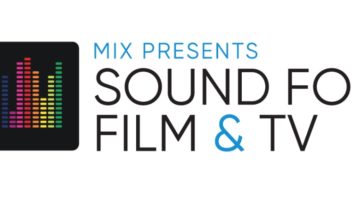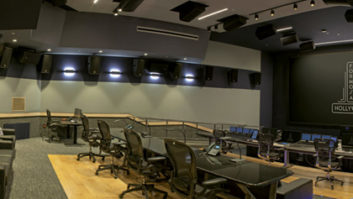As we walk through the hall at BMI in Nashville, which has graciously provided a huge conference room for this interview, Bob Johnston gets accosted by virtually everyone of a certain age who sees him. The receptionist will barely let go of him, telling an onlooker, “We go waaay back!” Harry Warner, another BMI veteran, shakes Johnston’s hand vigorously and reminds him, “You sure shook up this town.” Johnston, looking a bit more bedraggled in an open-necked shirt and Bolshevik’s beard next to Warner’s natty-blue sport coat and razor-creased Dockers, replies, “All I wanted to do was give the musicians in this town some work.” “You sure did,” Warner says.
What’s more, Johnston gave them the chance to work with artists who otherwise might never have passed through Nashville. And his light hand on the records he produced also probably helped those artists through doors that might not otherwise have opened. In Johnston’s case, as much as for any other producer ever profiled in Mix, the records speak for themselves: Bob Dylan’s Highway 61 Revisited, Blonde on Blonde, John Wesley Harding, Nashville Skyline, New Morning and Self Portrait; Simon & Garfunkel’s Parsley, Sage, Rosemary & Thyme, Sounds of Silence and Bookends; Leonard Cohen’s breathtaking Songs From a Room and Songs of Love and Hate; Johnny Cash’s ground-breaking live albums At Folsom Prison and At San Quentin; and countless other gems from artists including The Byrds, Marty Robbins, Patti Page, Willie Nelson, Dan Hicks and the New Riders of the Purple Sage.
The Fort Worth, Texas, native graduated from staff producer for Columbia Records in New York (1965-67) to running Columbia’s Nashville operations for a couple of years before becoming one of the industry’s first major independent producers. There were some rough years and the almost de riguer run-in with the IRS. But Johnston, now 70, remains an animated conversationalist with a sharp memory and an even sharper tongue.
What brought you to New York? You were starting to have some success as a songwriter.
A music publisher named Robert Mellin brought me up there. This was 1964. Someone there then helped me get a staff production job at Kapp Records. One day, I heard this great record by Aretha Franklin and I found out that Bob Mercy, who worked at Columbia Records, was the arranger. He was also a producer for Barbra Streisand and Andy Williams. I was doing one of my first productions, this new artist from North Carolina named Helena Troy, and I wanted Bob to do the string arrangements. Later, I ran into him in the hall, and he asked me if I had any songs for Andy or Barbra, and I said, “No, just some demos.” I played them, and he thought they were better than anything else he had, so he asked me if I wanted to work for him. I said, “Hell, no, but I’ll work with you.” He looked for an office for me but there were none available, so he found this broom closet down the hallway, started tossing pots and pans out of it, and said, “Here’s your office.”
What was your big break as a producer?
Mercy came over with this old record of Patti Page’s and said, “See what you can do with her.” I went to see a bunch of movie people in Hollywood and got this song called “Hush, Hush, Sweet Charlotte” [from the film of the same name], and we recorded it. I went to see Seymour Poe, who worked with [Darryl F.] Zanuck, and told him that there were seven other records out on this song — which wasn’t unusual in those days — but that Columbia would get behind Patti Page doing it, and there’d likely be an Academy Award nomination in it. He said, “You’ve got two minutes.” I put the record on his turntable, and you could see the opening string parts really got to him. Thirty seconds into the song, I pulled the needle off the record and he said, “What are you doing?” I said, “Your two minutes are up.” He says, “I’ll call you Monday.” I said, “You’ll call me later today.” He did, and that became a big record.
Sounds like you had to have more than talent in those days — you also needed testicular fortitude. What in your background gave you that?
My great uncle was a concert pianist. My grandmother wrote songs with the guy who wrote “When Irish Eyes Are Smiling,” and my mother wrote songs till she was 92, including “Miles and Miles of Texas,” which Gene Autry and Asleep At the Wheel recorded. I grew up in a musical element and I was very sure of myself when it came to music. When I was in the Navy, I stopped into a servicemen’s club in Boston and I was singing a song there, and in walks Frank Sinatra. I stopped singing, but he told me to go ahead and finish the song. He wouldn’t sing till I was finished. I saw him with his entourage and some great-looking women and thought, “That’s a great way to make a living.”
Not a lot has changed in the business since then. But you became a producer in an era when labels owned studios and staff producers were given artists almost as a matter of chance. How did you wind up producing Bob Dylan’s Highway 61 Revisited?
I heard him, and I wanted to work with him. He was a prophet, and in another few hundred years, they’ll realize he stopped the [Vietnam] War. Mercy asked me, “Why do you want to work with him? He’s got dirty fingernails and he breaks all the strings on his guitar.” But I wanted to. I was afraid they’d give him to [Byrds producer] Terry Melcher, so I had a meeting with John Hammond, Mercy and [Columbia Records president Bill] Gallagher, and they said, “Okay, you do him.”
Dylan had had a falling out with his previous producer, Tom Wilson. What did you bring to the picture, and what was your first meeting like?
It was in the Columbia Studios on West 52nd Street. I just walked up to him and said, “Hi, I’m Bob Johnston,” and he just smiled and said, “Hi, I’m Bob, too.” As for producing, I always say I’m someone who just lets the tapes roll, but anyone who can’t write songs, can’t sing, can’t produce, can’t perform really shouldn’t be working with an artist. You need to relate on their level, if for no other reason than you can stay out of their way when you need to. All of the other staff producers at Columbia were tapping their feet out of time and whistling out of tune and picking songs based on what their boss liked last week so they could keep their jobs three more months. But I figured Dylan knew something none of us knew, and I wanted to let him get it out. Also, I should tell you that though “Like a Rolling Stone” was on Highway 61, it was produced by Tom Wilson. I produced all the rest of the songs on it.
What were the sessions for Highway 61 like?
The old studios on 52nd Street were a big complex with tons of staff engineers. I walked in on the first day, and there was a German engineer in the studio waiting for me, and he said, “Vot are ve vorking on today?” I told him it was Bob Dylan, and he said, “Do ve haff to?” And I said, “Hell, no,” and got another engineer. [That turned out to be Mike Figlio, who also recorded Tony Bennett’s “I Left My Heart In San Francisco,” and who would follow Johnston down to Columbia Nashville a few years later.]
I don’t know how Tom Wilson recorded him, but when I did Dylan, we set up all of the musicians in the same room, with Bob behind a glass baffle so you could see him. With Dylan, you always had to keep your eye on him. He came in and played a song to the band once and that was how they learned it. He never counted off, just launched right into it, so you always had to keep the tape rolling. And that wasn’t easy at Columbia; we were using 4-track for that record, 8-track on Blonde on Blonde, and the machines were way down the hall. We had union engineers, so one would be in the control room at the console with me, and I’d say, “Roll tape,” and he’d tell his assistant near the door, “Roll tape,” and he’d yell down the hall to a guy at the other end, “Roll tape,” and then they’d start all over again yelling, “Is tape rolling?” God, it took 20 minutes to get those damned machines going. It was like a Three Stooges short. So I got in the habit of using several machines with Dylan so as not to lose anything. He would start a song on the piano, and if the musicians dropped out during it, he’d go to the guitar and start playing another one. I lost one song that way and said never again, so I always used multiple machines.
How do you mike a guy like that?
I always used three microphones on Dylan, ’cause his head spun around so much. I used a big [Neumann] U47 on him, same as I used on Johnny Cash later. I would put a baffle over the top of his guitar because he played while he sang lead vocals. I didn’t use any EQ on the band, just set the mics up right to make each instrument sound the best it could. I used some EQ on Dylan’s voice.
How did you help Dylan make the transition to Nashville forBlonde on Blonde?
I had been doing record sessions in Nashville with the old A-Team guys, like Grady Martin and Floyd Kramer. They were great musicians, but they were used to working a certain way. I’d ask them to play this or that part, and they’d say, “Nope, don’t want to play that.” They wouldn’t play anything they didn’t want to play. So, my wife talked to Ray Stevens’ wife and she told her about all these musicians who had moved up from Florida [and other parts of the South] to Nashville, guys like Jerry Kennedy and Wayne Moss and Kenny Butrey. I started using them on demo sessions there and liked them. I brought [harp player] Charlie McCoy up from Nashville to play guitar on Highway 61 and Dylan liked him. But not everyone thought recording in Nashville was a good idea.
When we were doing Highway 61, Bill Gallagher and [Dylan manager] Albert Grossman were in the studio when I mentioned to [Dylan] that maybe we should try recording in Nashville, they got these great musicians. Bob just kind of said, “Hmm,” and put his hand to his chin, looking like Jack Benny. That’s how he always was with a new idea — everything you ever said to him he always heard, but he never reacted right away. He’d just file it away, and it would come out later if he liked it. But a little later, Grossman and Gallagher came to me and said, “If you ever mention anything about Nashville again to Dylan, we’ll fire you. The reason being, we’re having too much success the way we’re doing it now.” I said, “Okay, you’re the boss. Then I took Dylan down to Nashville for Blonde on Blonde, and he loved working there.
Was it a radical shift in musicians, from guys like Mike Bloomfield to Jerry Kennedy?
We also bought some of the guys from The Band, like Rick Danko, who Dylan had been working with, and Al Kooper. I’ll tell you a great Al Kooper story: Al was in Nashville dressed in an undertaker’s hat and a black cape and high-heeled boots, real hippie-like, and he went down to Ernest Tubb’s Record Shop on Broadway. Well, the boys there didn’t care for the way he was dressed and they chased him out of there, and he ran into a phone booth to get away and called [Elvis Presley “Memphis Mafia” member] Lamar Fike, who came and rescued him in his Cadillac.
Bob got real into recording in Nashville. For the next record, John Wesley Harding, he was staying in the Ramada Inn down there, and he played me his songs and he suggested we just use bass and guitar and drums on the record. I said fine, but also suggested we add a steel guitar, which is how Pete Drake came to be on that record.
I have to ask about Dylan’s notorious vocal sound change forNashville Skyline.
If you listen to all of the records in a row — Highway 61, Blonde on Blonde, John Wesley Harding and Nashville Skyline — you’ll notice his voice changes on every one. It’s just something that happened. Skyline was just the most noticeable change. I never changed microphones on him. Hell, if he came in singing like The Chipmunks, and if Johnny Cash came in playing a ukulele, I couldn’t care less, because they all knew something no one else knew — they were artists.
You were recording Dylan at the same time you were working with Simon & Garfunkel?
Yes. Always had multiple albums going on at once. All at Columbia’s Studios in New York or Nashville. Highway 61 and Sounds of Silence were done at the same time, same for Blonde on Blonde and Parsley, Sage, Rosemary & Thyme, and John Wesley Harding and Bookends.
Did you ever get Simon & Garfunkel or Leonard Cohen down to Nashville?
Paul Simon came down for about a week once. But we did Songs From a Room with Leonard in Nashville.
You followed Tom Wilson onto Simon & Garfunkel as well, right?
I did. He was the one who had put the drums and band on [the song] “Sounds of Silence” while Paul was in England. But I did the rest of the album.
Dylan and Simon & Garfunkel must have been very different working experiences.
Very. Dylan was fast, and you never knew what he was going to do next. With Paul Simon, something in the studio might take an hour, it might take a day, a week, a month. He was very meticulous. He knew how to make records. He had made lots of demos, and he and Art had [made records] under the name Tom & Jerry. He really didn’t need me or Roy [Halee, then a Columbia staff engineer and soon to co-produce with Simon], except to bounce things off of.
Did they do their vocals together?
No, they overdubbed them separately. I don’t recall which microphones we used on them, but Paul helped choose those, too. He chose the musicians. He hired the newscaster to come in and record the [voice-over] for “7 O’Clock News/Silent Night,” another song that I think helped end that war.
You produced the two records that brought Johnny Cash’s career back to full steam, the live records from Folsom Prison and San Quentin.
Columbia didn’t want to do those, either. But I called Warden Duffy at Folsom Prison and set it up. Good thing, too. Sold 7 million records.
What was the equipment used forFolsom?
We had a truck full of whatever we could take from Columbia Studios in Nashville. Charlie Bragg, who was on staff at Columbia, was the engineer. The show was done in the prison cafeteria, and it was huge and echoing, and catwalks and hard surfaces everywhere. So, we put up as many mics as we could on the stage, sometimes a couple or three for each player, close in. We recorded it to 8-track. But it was the show that made itself, really. I think the most important thing I did on that recording was, instead of having an announcer work the audience up, I told Johnny to walk out there and just say, “Hello, I’m Johnny Cash.” You can hear the explosion after that.
You ran Columbia Records in Nashville for a short time before going independent. What prompted you to leave Columbia?
I knew I could do better on my own. After Highway 61 and Sounds of Silence, Columbia put together a pot for the staff producers, and I got $3,000 in addition to my pay as a staff producer. After Parsley, Sage and Blonde on Blonde, I got $6,000. For those records? Screw that. So I went off on my own.
And during the following two decades, you produced records for Willie Nelson, Tracy Nelson, the New Riders, and had a few hits, such as Michael Martin Murphey’s “Wildfire.”
I was never afraid of going independent. I never worried what would happen to me. I just moved forward.
To coin a phrase, what have you done lately?
I’ve formed a new record label called JAM, with myself, [former AM/FM/Clear Channel executive] Chuck Armstrong and [veteran music-business attorney] Paul Marshall. It’s going to be a record label that offers a Bill of Rights for recording artists. Too much of the business is determined by guys in suits these days, people who are too afraid of being fired instead of determined to make good music. In that kind of environment, there can’t be another Beatles or Stones.
Wasn’t it like that when you were staff at Columbia? Didn’t the “suits” have complete control over the artists?
Yeah, but they didn’t have complete control over me.
Dan Daley is Mix’s East Coast editor.







